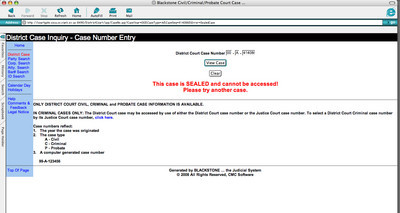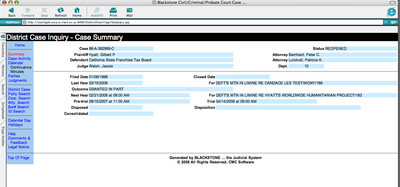Court begins unsealing records
The crypt at Clark County District Court inched open this month as the public got its first glimpse of court records once considered to be permanently hidden.
Looking to correct mistakes dating back 18 years, District Court administrators have taken on the tedious task of unsealing lawsuits and civil court documents incorrectly sealed years earlier.
A team of courthouse clerks is expected to work overtime in the coming weeks to identify hundreds of civil court filings, sort dozens of lawsuits from other sealed civil filings, examine each sealed lawsuit document by document, reclassify the records sealed correctly and unseal those that never should have been hidden from the public.
"On the computer, you will be able to find all the things (about a sealed case) that you have been able to find for regular cases," Steve Grierson, assistant clerk of the court, said of the case summaries available on the courthouse computer system.
The effort to clean up the court's civil-case records comes six weeks after the Nevada Supreme Court enacted new rules that prohibit judges from sealing entire lawsuits, and before the court activates a new case-management computer system later this year.
A state Supreme Court committee of judges, lawyers and media members recommended the new rules after a Review-Journal series last year showed that Clark County judges claimed authority to seal cases at their discretion and without providing justification.
The newspaper series also noted that litigants in many of the sealed cases were wealthy or influential individuals, organizations or companies.
Since 1990, clerks had sealed entire lawsuits from public view, even if judges ordered only certain parts sealed, because the courthouse's computer system was incapable of sealing specific records in a case, Grierson said. So, if a judge had wanted to maintain privacy only for a litigant's tax returns, trade secrets or Social Security number, the clerks' only option was to seal the entire case, he said.
As a result, the public has been unable to find out basic information on those cases, such as the names of the judge and attorneys in a case, the dates of hearings, the motions filed and other information.
Until now.
Armed with newer computer capabilities to seal individual records in a case, clerks now are expected to go back and review a judge's original sealing instructions in each lawsuit from years earlier, Grierson said. If the instructions spell out specifically which records were to be sealed, the clerk will keep sealed only those records and make public all other records in a case, he said.
The courthouse staff has examined only two cases so far, which means it's too early to tell how many sealed cases include detailed sealing instructions and how many included instructions that simply ordered clerks to seal an entire case, Grierson said.
The judges' original instructions also are sealed and available only to courthouse staff.
"If the order is that specific, I think we can do that. If it is detailed enough ... we will be able to follow those instructions," Grierson said.
So far, none of the sealed cases have been unsealed.
Only two cases have been "properly sealed," meaning a clerk examined the judge's sealing order, determined every document should remain sealed and then re-entered each document into the computer in such a way that the record makes more information about the case available to the public.
The public still won't be permitted to examine page-by-page a lawsuit as it could with a normal, unsealed case. However, instead of being met with an abrupt "This Case is Closed!" response from the courthouse computer, the public will be able to see the attorneys in a sealed case, the judge in a sealed case, the dates of filings and upcoming hearings, the title of each filing, summarized minutes of each hearing, some indication of a judge's rulings and other information.
A properly sealed case will remain sealed until someone files with the court a petition to unseal the case and a judge grants the request under the new state Supreme Court rules for sealing cases, Grierson said.
Washoe County District Court Judge Brent Adams, who co-chaired the state Supreme Court Commission, said Clark County's efforts are prudent because they are aimed at disclosing more information about cases sealed years earlier.
"That is a great step forward in serving the value that records of a public institution should be public," Adams said. "The clerk's office is making available to the public enough information in every single case to enable a person to bring a motion to the court to unseal a case. Without the name of the judge or anything else, how are you going to file a motion" to unseal a case?
The first sealed case examined by courthouse staff was a 1998 lawsuit, Gilbert Hyatt vs. California Franchise Tax Board, which is scheduled to go to trial in April.
The lawsuit was filed by a wealthy computer engineer. The lawsuit is still sealed, but, according to sources close to the case and the computerized information available for the first time, it alleges that California's income tax collectors acted inappropriately while investigating Hyatt's residency status in Nevada. Unlike California, Nevada doesn't collect income taxes.
For the first time since the case was sealed, the public can find out that Jessie Walsh is the judge and that Peter Bernhard, who served on the Nevada Commission on Ethics and the Nevada Gaming Commission, is the lead attorney representing Hyatt.
Other information available for the first time includes: the trial date and date of the next hearing in the case; dates and summarized minutes of each hearing in the case dating back to 1998; the date and title of each motion in the case; the fact that case activity includes 1,851 entries for hearings, motions and filings; and the fact the case had been closed and reopened at some point.
The process of properly sealing the Hyatt case took 30 hours, in part because it was the first case the staff examined and because there are more than 1,850 documents associated with a case Grierson described as "gargantuan."
Courthouse staff doesn't expect to spend nearly as much time on more typical sealed lawsuits, he said.
With dates of upcoming hearings available for the first time, the Review-Journal on Friday attended a pre-trial hearing in the Hyatt case. Even though the case is sealed, Walsh did not close the courtroom for the hearing or order the media to leave.
At the hearing, Walsh denied several motions filed by the California Tax Board. At one point, while arguing whether the tax collectors violated Hyatt's privacy rights, an attorney put up on a large screen Hyatt's tax, voter-registration and divorce records, some of which displayed his Social Security number, his address, his phone number and other information that previously had been confidential.
Pat Lundvall, a Reno attorney representing the California Tax Board, said it's been very helpful to have case information available online, and it's appropriate for the public to have access to more information about sealed cases.
"I can get this case, the case number, the documents that have been filed, where my matters are on her calendar. I really appreciate the work the staff has done," Lundvall said. "This case has a lot of moving parts, and knowing what motions have been filed on what day, what hearings were held each day ... it has made me more time efficient and cost effective. I can get this information online, which means I don't have to call the judge's secretary every time I need something."
Contact reporter Frank Geary at fgeary @reviewjournal.com or (702) 383-0277.


















